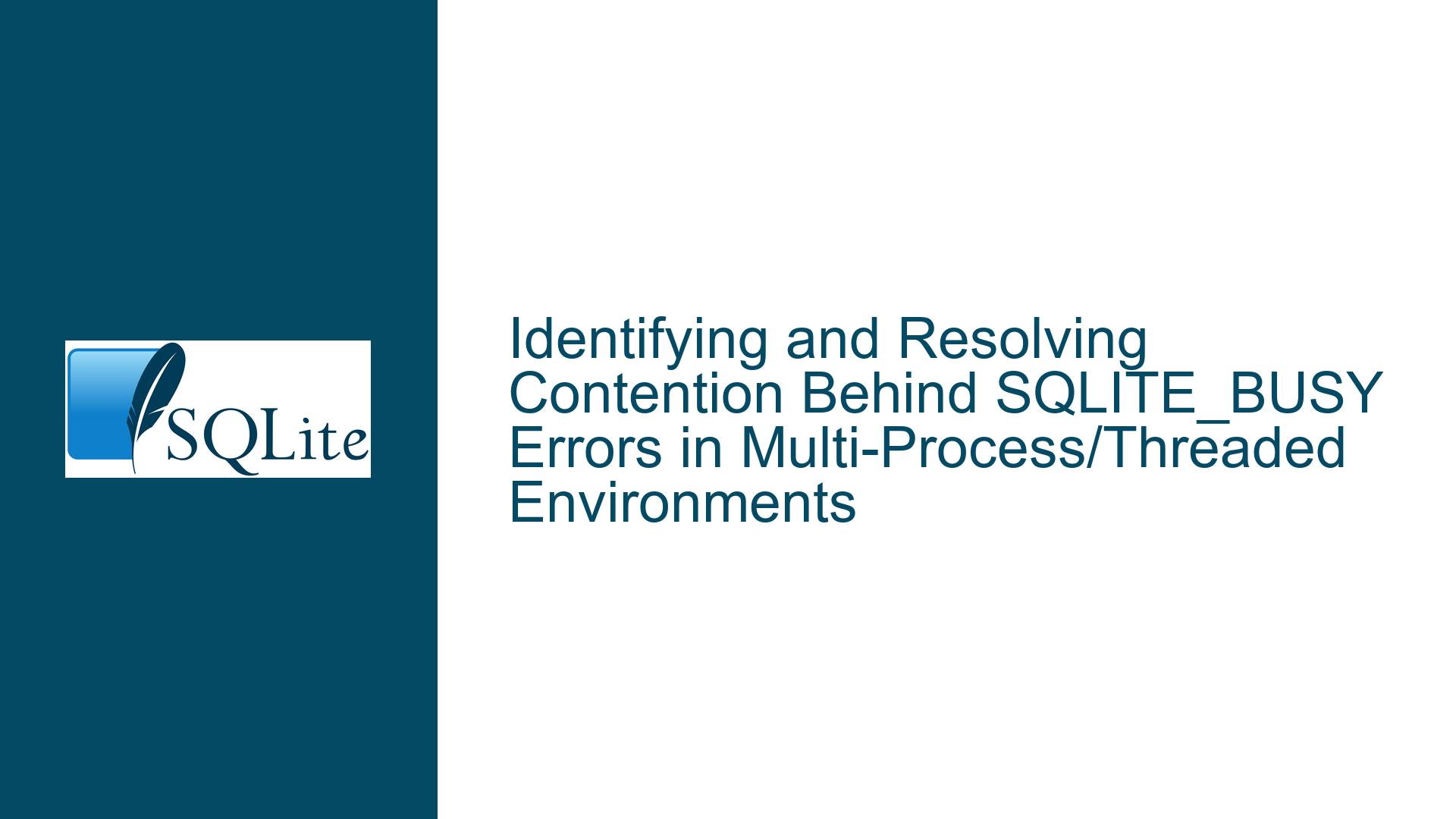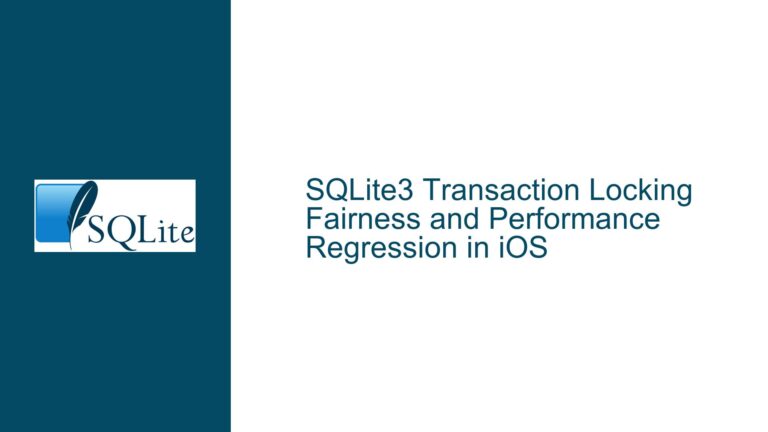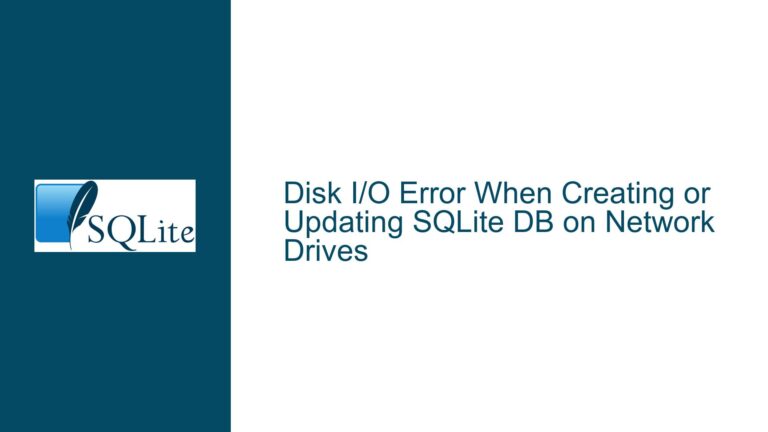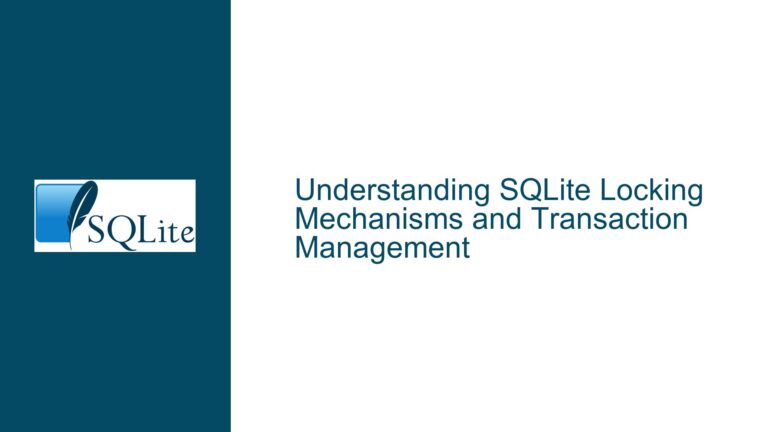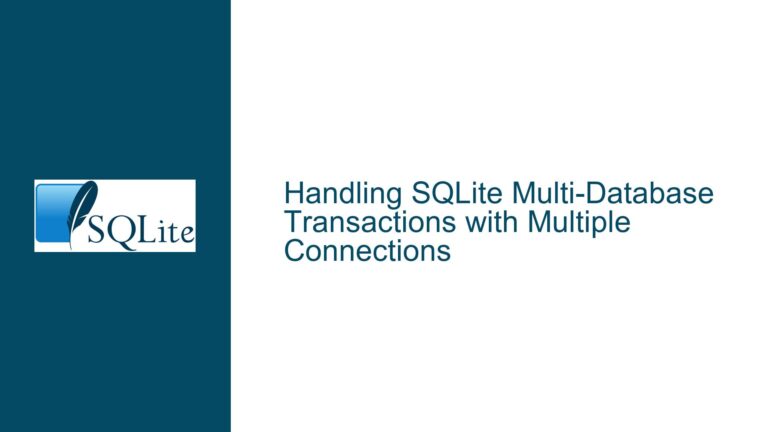Identifying and Resolving Contention Behind SQLITE_BUSY Errors in Multi-Process/Threaded Environments
Understanding SQLITE_BUSY: Locking Dynamics and Contention Scenarios
The SQLITE_BUSY error occurs when a database connection cannot acquire the required lock to proceed with an operation, typically during write transactions. SQLite employs a locking model that transitions through states such as SHARED, RESERVED, PENDING, and EXCLUSIVE. When one connection holds an EXCLUSIVE lock (e.g., during a write transaction), other connections attempting to write will receive SQLITE_BUSY until the lock is released. This error is common in multi-process or multi-threaded applications where concurrent access is not adequately coordinated. However, diagnosing the exact source of contention—whether it stems from a misbehaving thread, an unyielding process, or a long-running transaction—is non-trivial due to SQLite’s minimal runtime introspection tools.
The challenge intensifies when multiple processes or threads share the same database file. SQLite does not natively expose metadata about active connections or their current operations, making it difficult to attribute contention to specific code paths. Developers often rely on indirect methods, such as logging or custom instrumentation, to identify the offending process or query. This section explores the mechanics of SQLITE_BUSY, emphasizing scenarios like overlapping transactions, improper connection management, and the absence of retry logic, which exacerbate contention.
Root Causes of SQLITE_BUSY: Process/Thread Interactions and Configuration Pitfalls
1. Uncoordinated Multi-Process Access
SQLite assumes that processes coordinate access to the database file externally. When multiple processes perform writes without synchronization (e.g., via file locks or application-level semaphores), contention arises. For example, Process A might initiate a transaction but delay committing it, while Process B attempts to write to the same table. SQLITE_BUSY will persist until Process A releases its lock. This is particularly problematic in environments where processes are independently scheduled (e.g., cron jobs, microservices).
2. Long-Running Transactions
A transaction that remains open for an extended period (e.g., due to unoptimized queries, network delays, or user input waits) increases the window for contention. If Connection 1 executes BEGIN IMMEDIATE but takes seconds to prepare and commit changes, Connection 2’s write attempts during this period will fail with SQLITE_BUSY. This is common in applications that hold transactions open while performing non-database work.
3. Inadequate Busy Handling
SQLite provides a sqlite3_busy_handler or sqlite3_busy_timeout mechanism to retry operations after a SQLITE_BUSY error. Applications that do not implement these handlers—or configure insufficient retry intervals—will surface the error to users instead of resolving it transparently. For instance, setting busy_timeout to 2000 milliseconds allows SQLite to retry locked operations for up to 2 seconds, often resolving transient contention.
4. Misconfigured Journaling Modes
The choice of journaling mode (e.g., DELETE, TRUNCATE, WAL) impacts concurrency. WAL (Write-Ahead Logging) mode allows concurrent reads and writes, significantly reducing SQLITE_BUSY occurrences. Applications using the default rollback journal (DELETE mode) are more prone to contention, as writers must obtain an exclusive lock before modifying the database. Failing to enable WAL in high-concurrency environments is a frequent oversight.
5. Thread-Local Connection Misuse
In multi-threaded applications, sharing a single database connection across threads without synchronization guarantees leads to undefined behavior, including spurious SQLITE_BUSY errors. Each thread should use a dedicated connection. Alternatively, connections must be guarded by mutexes, which adds complexity. Language-specific wrappers (e.g., Python’s sqlite3 module) may exacerbate this by implicitly sharing connections unless explicitly managed.
6. File System Latency and Locking
Networked or legacy file systems (e.g., NFS) may not reliably handle file locks, leading to false positives where SQLite perceives contention due to lock misreporting. Similarly, antivirus software or backup tools that briefly lock database files can trigger SQLITE_BUSY.
Diagnosing and Mitigating SQLITE_BUSY: Instrumentation, Configuration, and Code Practices
Step 1: Enable SQLite’s Built-in Diagnostics
Activate SQLite’s internal logging using sqlite3_config(SQLITE_CONFIG_LOG, logCallback, data); to capture low-level locking events. The log callback receives messages detailing lock acquisition attempts, timeouts, and errors. For example:
void logCallback(void* data, int errCode, const char* msg) {
fprintf(stderr, "SQLITE_LOG (%d): %s\n", errCode, msg);
}
This reveals sequences like:
SQLITE_LOG (5): cannot acquire lock due to contention (SQLITE_BUSY)
While verbose, this helps correlate errors with specific operations.
Step 2: Instrument Custom Busy Handlers
Implement a custom busy handler to log contention context. The handler fires when SQLITE_BUSY is encountered, allowing you to inject diagnostic logic:
int busyHandler(void* data, int retries) {
log("Retry %d: Connection %p waiting for lock held by...", retries, data);
return retries < 5; // Retry up to 5 times
}
sqlite3_busy_handler(db, busyHandler, db);
To identify the blocking connection, pair this with a shared registry of active connections. Each connection’s sqlite3* handle and last executed statement can be tracked. For example:
std::map<sqlite3*, std::string> connectionRegistry;
void logActiveConnections() {
for (auto& [conn, query] : connectionRegistry) {
log("Connection %p is executing: %s", conn, query.c_str());
}
}
Modify the busy handler to invoke logActiveConnections(), providing visibility into which connections are active during contention.
Step 3: Leverage PRAGMA data_version
The data_version pragma returns a monotonically increasing integer that changes whenever the database is modified. Polling this value from separate connections helps detect which process/thread is modifying the database:
PRAGMA data_version;
If Process A’s data_version increments while Process B encounters SQLITE_BUSY, A is likely the culprit. This is lightweight compared to full query logging but requires coordination between processes.
Step 4: Audit Transaction Boundaries
Ensure transactions are as short-lived as possible. Use BEGIN IMMEDIATE or BEGIN EXCLUSIVE to acquire locks early, reducing the window for contention. For example:
# Python example
conn.execute("BEGIN IMMEDIATE")
try:
# Perform writes
conn.execute("INSERT INTO logs (message) VALUES (?)", ("test",))
conn.commit()
except sqlite3.OperationalError as e:
if "database is locked" in str(e):
log("Contention detected; retrying...")
conn.rollback()
Additionally, avoid holding transactions open during I/O operations or user interactions.
Step 5: Adopt WAL Mode
Enable Write-Ahead Logging to allow concurrent reads and writes:
PRAGMA journal_mode=WAL;
WAL mode reduces the frequency of SQLITE_BUSY by permitting readers to coexist with a single writer. However, it requires periodic checkpointing and is incompatible with networked file systems in some cases.
Step 6: Profile File Locks Using External Tools
On Unix-like systems, use lsof or fuser to identify processes holding database file locks:
lsof /path/to/database.db
This lists the PID and file descriptors of processes with open handles. Correlate these PIDs with application logs to pinpoint offenders.
Step 7: Implement Retry Logic with Exponential Backoff
Wrap database operations in retry loops that handle SQLITE_BUSY gracefully. For example, in C:
int execute_with_retry(sqlite3* db, const char* sql) {
int rc, retries = 0;
do {
rc = sqlite3_exec(db, sql, NULL, NULL, NULL);
if (rc == SQLITE_BUSY) {
usleep((1 << retries) * 1000); // Exponential backoff
retries++;
}
} while (rc == SQLITE_BUSY && retries < MAX_RETRIES);
return rc;
}
Adjust MAX_RETRIES and backoff intervals based on expected contention levels.
Step 8: Thread and Connection Pool Sanitization
Ensure each thread uses a distinct connection and that connections are promptly closed after use. For connection pools, validate that connections are not leaked or reused without resetting their state. For example, in Java:
DataSource pool = ...;
try (Connection conn = pool.getConnection()) {
// Use connection
} // Automatically returned to the pool
Step 9: Analyze Schema and Query Patterns
Long-running write queries (e.g., bulk inserts without indexing) prolong lock retention. Use EXPLAIN QUERY PLAN to identify inefficient queries:
EXPLAIN QUERY PLAN INSERT INTO large_table SELECT * FROM csv_import;
Optimize schemas with appropriate indexes, and batch large writes into smaller transactions.
Step 10: Isolate Contention via Minimal Reproducible Examples
If the issue remains elusive, reproduce it in a controlled environment. For example, simulate concurrent access using shell scripts:
# Process 1
while true; do
sqlite3 test.db "BEGIN; INSERT INTO t VALUES (random()); SLEEP(1); COMMIT;"
done
# Process 2
while true; do
sqlite3 test.db "INSERT INTO t VALUES (random());"
done
Monitor which process triggers SQLITE_BUSY in the other, adjusting parameters (e.g., sleep duration) to replicate the production scenario.
Final Recommendations
Addressing SQLITE_BUSY requires a blend of proactive design (WAL mode, proper transactions), runtime instrumentation (busy handlers, logging), and post-hoc analysis (file lock inspection). By systematically eliminating common pitfalls and incrementally introducing diagnostics, developers can isolate contention sources and implement targeted fixes.
